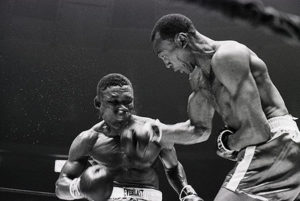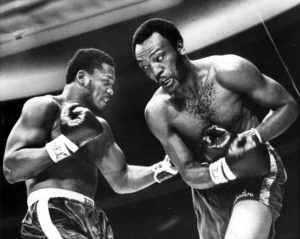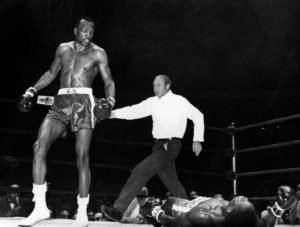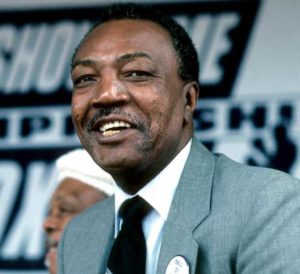
The Skills of Bob Foster, Light Heavyweight Champion 1968-74
Bob Foster reigned as light heavyweight king, after knocking out Dick Tiger in 1968, and defended his title a staggering 14 times until 1974. There’s no doubt, that Bob Foster made a strong case for being one of the most impressive light heavyweight champions in boxing history, and up until he vacated the light heavyweight title, his only losses in his career came against heavyweights. He was undefeated as a light heavyweight in his reign. No matter how big the heart, a man doesn’t get to defend his title 14 times without an extraordinary amount of skill, so let’s break down the different aspects of ‘The Deputy Sherriff’s’ fight game.
Defence Against Straight Punches (00.10-1.20)
Bob Foster could be an extremely slippery opponent at times, particularly for fighters who chose to use straight punches as their main method of offence. With attentive timing and good judgement, Foster was able to evade jabs and straight rights with ease, with a ‘simple’ bend at the waist, moving out of the way from jabs or straights, and having the punch sail over his shoulder.
This was natural for Foster to utilise because of the fact he fought with a side-on stance, much like an Ezzard Charles or a Joe Louis. Fighting in a side-on stance protects your centre-line (torso), increasing the effort needed from your opponent to hit you with effective punches.
Dipping under a punch, rather than intercepting it in mid-flow, allows it to continue on it’s journey. This means that the opponent’s momentum will continue moving forward excessively, onto the front foot and forcing a temporary loss of balance control. With his opponent off balance and overreaching with his punch, this presented a quick counterpunching opportunity for Bob Foster.

Bob Foster had a lethal right hand
Parry (1.25-1.50)
To increase the effectiveness of his bending at the waist, Bob Foster would add a parry as a secondary defensive method. Bob Foster’s parry was done by allowing the punch to enter within inches of himself, and palming it away from the intended target. This was a useful method of defence when Foster wasn’t quick enough to dip under a jab.
More than simply just catching your opponents punch with an open-glove, Bob Foster would use the parry to redirect his opponents punch, which more importantly would redirect the moving momentum of his opponent’s punch, causing a loss of control over their balance, and yet another counterpunching opportunity.
Feints (1.55- 3.00)
Bob Foster was undefeated when he reigned as light heavyweight champion, and his only real losses came against heavyweights much bigger than him who he had trouble backing up. With other light heavyweights though, Foster was menacing as he walked his opponent’s down. Rather than just plodding forward, giving his opponent little to think about, he would use feints to create a sense of urgency in his opponent.
As he was stepping forward, Foster would shift forward, faking intentions to throw a jab. This would usually have his opponent overreacting, skipping from corner to corner in a desperate attempt to keep away from Foster’s attempt to set up offence. However, the real set up was in his opponent’s reaction to the feints, as while Foster would simply shift forward with minimal effort, his opponent would spend his energy trying to evade punches that are not even certain to come. Then as his opponent decided to adapt his game plan to a more economic approach by standing his ground more and being less reactive to the feints, this made it easier for Foster to land his jabs as a result of his opponent being left in a state of confusion, and unable to distinguish between real cues and fake cues, suggesting an incoming punch.
This also made for a great way to cut off the ring. By taking large steps into the direction that his opponent was moving, Foster’s imposing giant figure was extremely effective in keeping his opponent in check when he wanted to hunt down his prey.
Jabs (3.05-4.28)
Up-jab (3.08- 4.07)
Bob Foster wasn’t a fighter who carried his hands high. This allowed for another addition to Foster’s arsenal of skills: the up-jab. Much like many other fighters who adopt a side-on stance with a low lead hand, Foster lifted his jab from it’s starting position, landing the top of his knuckles on his opponents chin and nose from a low angle.
Coming from such a low starting point makes the punch harder to see coming, catching his opponent by surprise. In order to make the punch even more effective, Foster would spring up with the jab by bending at the waist to make himself a small target, then springing up with the jab to generate power. This also served to make Foster an elusive target while throwing, keeping his opponent from being able to counter-jab him.
With Bob Foster being taller than his opponent’s, the plan for many fighters was to try back him up, or smother him with inside flurries. Fighters coming in from a crouching stance would be met with a stiff up-jab, which would catch them moving directly into the punch. A perfect remedy for keeping his opponent at bay.
Quick fire jabs (4.08- 4.27)
As if the up-jabs weren’t discouraging enough, Bob Foster would throw quick fire jabs, to keep his opponent at his preferred range. Foster would launch multiple jabs, in the three’s, four’s and five’s, keeping his opponent occupied and unable to focus on setting up the own offence.
Jab Hook (4.28- 5.11)
A favourite of Foster’s, was to hook off the jab. This was a efficient way of setting up his offence due to the fact that the instinctive expectation is that a right hand punch will follow a jab, rather than a left hook. For opponents who usually roll with right hands, this meant they would usually roll themselves right into the left hook, catching them moving into the punch.
The jab hook combination was also useful against fighters moving to their own left, as sometimes this movement could smother Foster’s right hand, but on the other hand create space for a left hook.
When his opponent’s weren’t moving themselves, Foster would take matters into his own hands and step to the left himself whilst throwing the jab. Not only did this create room for the left hook, but it also helped to expose his opponent’s centreline, with some fighters turning slightly to face their right to protect/ hide their centreline.

Bob Foster was often taller than his opponents
Head pull
As with many tall fighters facing smaller fighters who look to get on the inside of their opponent, Foster would sometimes sneakily use his palm to pull his opponents in close to his chest. This forced his opponent into such close range that they had no room for punching, and were forced into a clinch. The effectiveness of this, is in the disruption of his opponent’s forward momentum, forcing his opponent’s weight onto their front foot and causing them to lean.
Right hand
Bob’s right hand could be truly destructive when Foster was at his peak. It was usually set up with a feinted or flicking jab. A favourite of Foster’s was to execute his dip to make himself a smaller target, and put himself in a stance that makes his punch harder to read. As he done this, he would feint or jab to the body, and come up with an unexpected right hand to the head. When Foster decided to commit to the jab, he would leave his long left arm extended to keep his opponent occupied, and even off balance, before the right hand caught his opponent clean on the chin.
At times, his stepping feints would have his opponent in such a desperate state, that they would lose defensive focus. This could often result in his opponent urgently moving right into the direction of a right hand from Foster.

Bob Foster’s KO’s were usually intelligently set up.
Backwards movement
The backwards movement of Bob Foster to set up his right hands was maybe my favourite subtlety of Bob Foster. Foster’s style of fighting seemed to always provoke his opponent into reaching forward or overextending himself. Foster would take advantage of this by stepping backwards as his opponent’s punch came forward, then launching a counter right hand off of a spring loaded back leg and forward-falling opponent. Foster didn’t like to fight on the back foot for long periods, but in short moments, Foster was great at using backwards movement to set up offence momentarily.

Bob Foster was inducted into the Boxing Hall of Fame
Final Note
Foster’s record speaks for itself. At his peak, Foster’s skills, combined with his imposing figure and professional approach, resulted in domination against his opponent on numerous occasions. Much of Foster’s success in the ring, is widely justified as a result of his punching power, but that does the great man a great disservice. For despite the relative lack of charisma and showiness in Foster’s fight game, he certainly displayed distinctive character and patience in the way that he went about his business. All of his most notable knockouts were set up with intelligence, more so than the brute force that he is widely known for. Bar his attempts to challenge the big men at the top of the divisional piles, Foster’s domination over the light heavyweights certainly merits a permanent spot in boxing history.

Leave a Reply
Be the First to Comment!